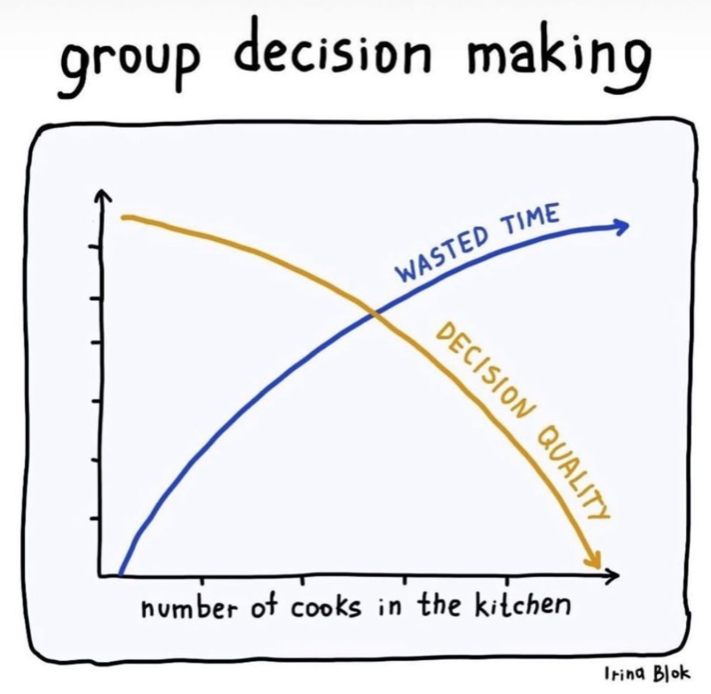
Group decision-making is a double-edged sword. When managed well, it leads to better ideas, stronger buy-in, and fewer blind spots. When done poorly, it results in endless debates, analysis paralysis, and wasted time.
As more people get involved, decision quality initially improves—until a tipping point where diminishing returns and inefficiencies kick in.
So how do we strike the right balance? Let’s explore the good, the bad, and the practical solutions to improve decision-making in everyday tech teams.
The Good: When Group Decision-Making Works Well
Marketing Team Collaborating on a New Campaign
Example: A SaaS Startup’s Product Launch
A B2B SaaS company is rolling out a new feature. The marketing team collaborates with product managers, sales reps, and customer success to ensure the messaging resonates with users.
- Why it works: Sales provides real-world objections, customer support highlights frequent issues, and product managers ensure accuracy.
- Outcome: A stronger campaign that converts better.
Sales Team Deciding on Pricing Strategies
Example: A Mid-Sized Software Company Adjusting Subscription Plans
Before introducing a new pricing model, the sales team works with finance, customer success, and product management to ensure the change aligns with revenue goals.
- Why it works: Finance ensures profitability, customer success highlights customer friction, and product sets value-based pricing.
- Outcome: A well-balanced pricing strategy that maximizes revenue while reducing churn.
Engineering Team Conducting an Incident Post-Mortem
Example: A FinTech Company Investigating a System Outage
After a major system outage, the engineering team collaborates with DevOps, security, and customer support to analyze what went wrong and how to prevent future failures.
- Why it works: Each team provides unique perspectives—DevOps on infrastructure, security on vulnerabilities, and support on customer impact.
- Outcome: A robust root-cause analysis that improves system resilience.
Data Team Defining Company-Wide Metrics
Example: A Marketplace Platform Aligning on North Star Metrics
The data team works with marketing, product, and leadership to define core KPIs (e.g., Monthly Active Users vs. Revenue Per Customer).
- Why it works: Aligning on a single source of truth prevents teams from reporting conflicting numbers.
- Outcome: More consistent reporting, better decision-making, and reduced data disputes.
The Bad: When Group Decision-Making Backfires
Marketing Overcomplicating a Simple Decision
Example: Endless Debate Over an Ad Copy Change
The marketing team involves ten or more stakeholders in choosing between two tagline variations for a campaign. Instead of running an A/B test, they debate for weeks.
- Why it fails: Subjective discussions replace quick, data-driven decisions.
- Outcome: A delayed campaign and lost potential leads.
Sales Team Adding Too Many Stakeholders to Deals
Example: Slowing Down Closing Deals
The sales team at a cybersecurity firm requires approval from sales ops, legal, finance, and engineering before finalizing a contract.
- Why it fails: The complexity slows down the sales cycle, causing prospects to choose a faster-moving competitor.
- Outcome: Lost revenue due to unnecessary bureaucracy.
Finance Making Budget Cuts Without Proper Input
Example: Cutting Data Infrastructure Costs Without Context
The finance team at a mid-sized e-commerce company slashes cloud computing costs without consulting data engineers.
- Why it fails: The engineering team loses access to necessary resources, causing data pipeline failures that disrupt product recommendations.
- Outcome: Lower conversion rates and lost sales due to broken personalization features.
Engineering Team Overcomplicating a Tech Stack Decision
Example: Too Many Opinions on Which Framework to Use
A startup’s engineering team debates whether to use React, Vue, Angular, or Svelte for months instead of making a decision.
- Why it fails: Over-analysis delays development instead of focusing on delivering features.
- Outcome: The company falls behind competitors.
How to Improve Group Decision-Making: Time Limits & Guardrails
Without clear time limits and decision-making frameworks, group discussions can drag on, leading to decision paralysis.
Set Time Limits Based on Decision Type
| Decision Type | Time Limit | Example |
|---|---|---|
| Quick Operational Decisions | 10-30 min | Choosing an ad copy variation. |
| Mid-Level Team Decisions | 24-72 hours | Deciding on a pricing discount. |
| Strategic/Cross-Functional | 1-2 weeks | Choosing a new tech stack. |
| High-Stakes Executive Decisions | 1 month max | Merging with another company. |
Rule of Thumb: If no decision is made within the time frame, the designated decision-maker should make the call based on available data.
Use Guardrails to Keep Discussions Focused
- Use a “Disagree & Commit” Rule
- If a discussion exceeds its time limit, team members should express concerns but commit to moving forward.
- Limit Participants to Those Who Truly Matter
- Jeff Bezos’ “Two-Pizza Rule”: If a team can’t be fed with two pizzas, it’s too big for decision-making.
- Leverage Decision-Making Frameworks
- DACI (Driver, Approver, Contributor, Informed) for project-based decisions.
- Majority Voting or Weighted Scoring Models for objective decision-making.
Final Thoughts: Collaboration vs. Overcomplication
Great group decision-making is about balance.
- Collaborate when it adds value.
- Set clear decision roles and time limits.
- Avoid overcomplicating tactical decisions.
Without guardrails, decision-making becomes slow, frustrating, and ineffective. By structuring group input the right way, companies can move faster and smarter without falling into the trap of too many cooks in the kitchen.
What’s the biggest decision-making bottleneck you’ve faced?
How does your team handle decision deadlocks?
Drop your thoughts in the comments.